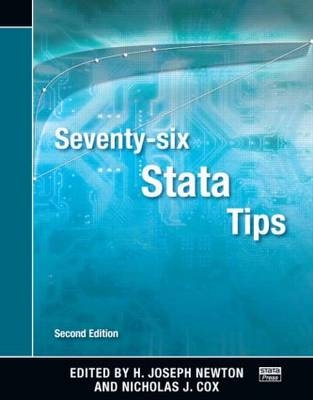
Seventy-six Stata Tips, 2nd Edition
Stata Press (Verlag)
978-1-59718-071-9 (ISBN)
- Titel ist leider vergriffen;
keine Neuauflage - Artikel merken
Since 2003, the Stata Journal has included Stata Tips on special issues in data analysis with Stata. Seventy-six Stata Tips, 2nd Edition compiles these useful guides into a compact tome for ease of reference. In keeping with the Stata spirit, Tips are from Stata users and StataCorp employees alike and will serve as guideposts for both new and experienced users. Seventy-six Stata Tips includes the first 33 tips of the series, previously published in the book Thirty-three Stata Tips.
Introoducing Stata tips. The eform() option of regress. Building with floors and ceilings. How to be assertive. Using display as an online calculator. Ensuring programs preserve dataset order. Inserting awkward characters in the plot. Copying and posting under Windows. Splitting time-span records with categorical time-varying covariates. Following special sequences. Fine control of axis title positions. The nolog option with maximum-likelihood modeling commands. Tuning the plot region aspect ratio. Generate and replace use the current sort order. Using value labels in expressions. Function graphs on the fly. Using input to generate variables. Filling in the gaps. Making keys functional. A way to leaner, faster graphs. Generating histogram bin variables. The arrows of outrageous fortune. Variable name abbreviation. Regaining control over axis ranges. Axis labels on two or more levels. Sequence index plots. Maximizing compatibility between Macintosh and Windows. Classifying data points on scatter plots. Precise control of dataset sort order. For all times and all places. May the source be with you. Scalar or variable? The problem of ambiguous names. Do not stop. Sweet sixteen: Hexadecimal formats and precision problems. Tabulation by listing. Detecting whether data have changed. Which observations? And the last shall be first. Testing for groupwise heteroskedasticity. In a list or out? In a range or out? Which observations? Erratum. Taking care of business. Monitoring loop iterations. The overlay problem: Offset for clarity. Remainders, selections, sequences, extractions: Uses of the modulus. Get a handle on your sample. Getting those data into shape. Step we gaily, on we go. Quantile–quantile plots without programming. Discrete uses for uniform()1. Range frame plots. Efficient use of summarize. Events in intervals. Generating composite categorical variables. Where did my p-values go? Post your results. Better axis labeling for time points and time intervals. Writing parameterized text files. How to reinstall Stata. nl is not just for nonlinear models. Plotting on any transformed scale. Making fast and easy changes to files with filefilter. Decimal commas in results output and data input. Plotting on reversed scales. Modeling proportions. Cleaning up user-entered string variables. Beware the backstabbing backslash.ds—A hidden gem. J() now has greater replicating powers. Producing log files based on successful interactive commands. Beware the evaluating equal sign. The problem of split identity, or how to group dyads. Using the Graph Recorder to create a pseudograph scheme. append with care!1 firstonly, a new option for tab2. Setting up Stata for a presentation. Separating seasonal time series.
| Erscheint lt. Verlag | 4.12.2009 |
|---|---|
| Verlagsort | College Station |
| Sprache | englisch |
| Maße | 152 x 229 mm |
| Gewicht | 386 g |
| Themenwelt | Mathematik / Informatik ► Mathematik ► Computerprogramme / Computeralgebra |
| ISBN-10 | 1-59718-071-8 / 1597180718 |
| ISBN-13 | 978-1-59718-071-9 / 9781597180719 |
| Zustand | Neuware |
| Informationen gemäß Produktsicherheitsverordnung (GPSR) | |
| Haben Sie eine Frage zum Produkt? |
aus dem Bereich


